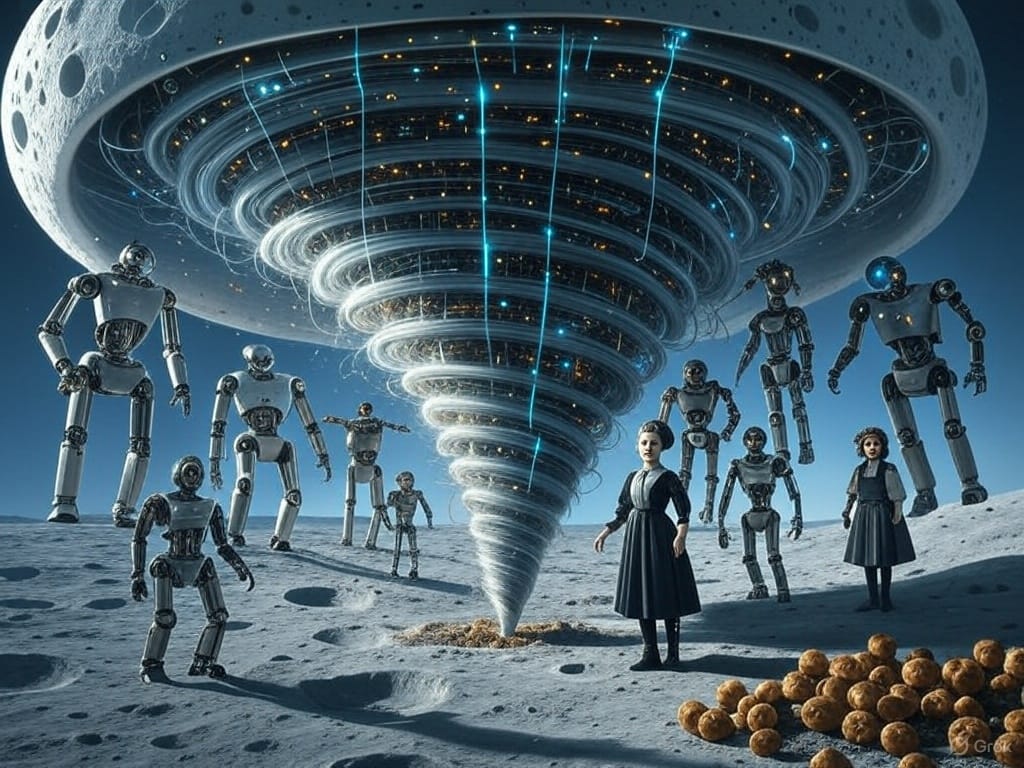
By Elke Porter | WBN News Global | May 15, 2025
Buckle up, folks—new technology is popping up faster than memes on your feed, and keeping up feels like chasing a Wi-Fi signal in a storm. From robots to quantum computers to helium isotopes with out-of-this-world vibes, the tech world is a dizzying blend of acronyms and breakthroughs.
Let’s break it down with a dash of humor, tackling what separates a robot from a cobot, why helium-3 is the cool kid on the periodic table (complete with its superfluid antics), and how quantum computers are doing some divinely beautiful, dazzlingly clever, and angelically good things—because, like Anne of Green Gables might have asked, why not be all three? Plus, we’ll toss in a couple more tech tidbits to keep you in the loop without needing a PhD or a caffeine IV drip.
Robots, Cobots, Bots, and… Droids? Oh My!
Picture this: a robot is assembling cars, a cobot is high-fiving its human coworker, a bot is spamming your DMs, and a droid is… well, probably chilling with R2-D2. So, what’s the deal? A robot is your classic automated machine—think industrial arms welding in factories or that vacuum cleaner you swear is plotting against your cat. They’re programmed for specific tasks and don’t play well with others (humans, that is). A cobot, or collaborative robot, is the friendly cousin, designed to work alongside humans, sharing tasks like a buddy passing you tools—think of it as the workplace equivalent of a golden retriever.
A bot is software, not hardware, sneakily automating tasks like answering customer service chats or, less charmingly, flooding your inbox with “You’ve won a free cruise!” scams. And a droid? That’s just a robot with Star Wars swagger—fictional, but we’re jealous of their charisma. With automation booming, understanding these distinctions is key as industries lean on cobots for teamwork and bots for grunt work.
Helium-3: The Superfluid Superstar
Helium’s not just for balloons at your nephew’s birthday party—it’s got a high-tech side that’s out of this world. Forget super helium; the real MVP is helium-3, a rare isotope with two protons and one neutron, unlike helium-4’s two-and-two setup. Cool it to near absolute zero, and helium-3 turns into a superfluid, a bizarre state where it defies physics by climbing jar walls like a rebellious teenager sneaking out. This zero-viscosity trick makes it a cryogenics champ, keeping quantum computers frosty.
Why’s it important? Helium-3 is the golden ticket for nuclear fusion, promising clean energy with less radioactive waste. It’s scarce on Earth but abundant on the moon, fueling dreams of lunar mining—China’s already plotting missions. Plus, its role in medical imaging like MRIs makes it a healthcare hero. Helium-3’s superfluid swagger and fusion potential make it a cosmic game-changer.
Quantum Computers: Superposition, Entanglement, and Tunneling, Oh Wow!
Quantum computers are the tech equivalent of a magician pulling a rabbit out of a hat—except the hat’s a supercooled chip, and the rabbit’s a solution to problems that’d make supercomputers cry. These machines are divinely beautiful, dazzlingly clever, and angelically good, just like Anne of Green Gables might dream. Let’s decode the jargon. Superposition is like a qubit (quantum bit) being a multitasker, existing as both 0 and 1 at once until measured, unlike a classical bit’s boring “pick one” vibe. Imagine flipping a coin that’s heads and tails until you peek—boom, that’s superposition, letting quantum computers crunch multiple possibilities simultaneously.
Entanglement is the out-of-this-world part: when qubits get so chummy that one’s state instantly affects another, no matter how far apart. It’s like if your coffee order changed because your friend in Tokyo sneezed—Einstein called it “action at a distance.” This correlation supercharges quantum speed.
Tunneling? That’s a quantum particle cheekily slipping through energy barriers like a ghost through a wall, helping qubits explore solutions faster than classical computers trudging the long way. Together, these quirks make quantum computers potential game-changers for cryptography, drug discovery, and cracking problems that’d take classical systems eons. Google’s Sycamore chip, for instance, solved a task in 200 seconds that’d take a supercomputer 10,000 years.
Two More Tech Tidbits to Tickle Your Brain
- Neuromorphic Computing: Brains, but Make It Silicon
Ever wish your computer thought like you, minus the existential crises? Neuromorphic computing mimics the human brain’s neural networks, using chips that process info like neurons firing. Unlike traditional CPUs chugging through linear tasks, neuromorphic chips handle messy, real-world data—like recognizing faces or dodging traffic—with less power. Intel’s Loihi chip, for example, learns on the fly, making it a darling for AI and robotics. It’s like giving your laptop a coffee and a pep talk, minus the jitters. - Photonic Computing: Surfing Light Waves
Forget electrons—photonic computing uses light (photons) to zip data around, laughing in the face of electrical resistance. These systems promise blazing-fast, energy-efficient processing for AI and big data. Imagine your computer running at the speed of light, literally. Startups like Lightmatter are building photonic chips that could make today’s processors look like dial-up modems. It’s tech so slick, it practically wears sunglasses.
Riding the Tech Wave with a Smile
The tech world is a wild ride, spinning out robots, cobots, bots, and droids, plus helium-3’s superfluid stunts and quantum wizardry that’s divinely beautiful, dazzlingly clever, and angelically good. Superposition, entanglement, and tunneling are turning computing into a sci-fi epic, while neuromorphic and photonic systems add more plot twists.
Keeping up might feel like herding cats in a hurricane, but it’s worth it—new tech isn’t just reshaping industries and adding hundreds of new words to the dictionary; it’s rewriting what’s possible. So, grab a metaphorical surfboard, chuckle at the jargon, and dive into the future. Who knows? Your next coworker might be a cobot, and your coffee might be powered by the moon.
#Tech Tornado #Quantum Computing #Helium3 #Robots Vs Cobots #Superfluid Science #Future Tech #WBN News Global #Elke Porter
Connect with Elke at Westcoast German Media or on LinkedIn: Elke Porter or contact her on WhatsApp: +1 604 828 8788


